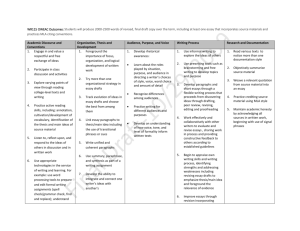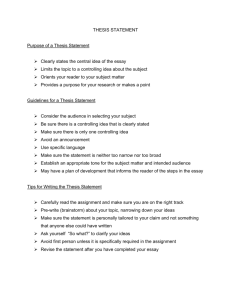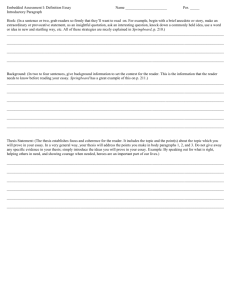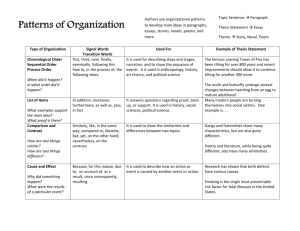workshop handout
advertisement
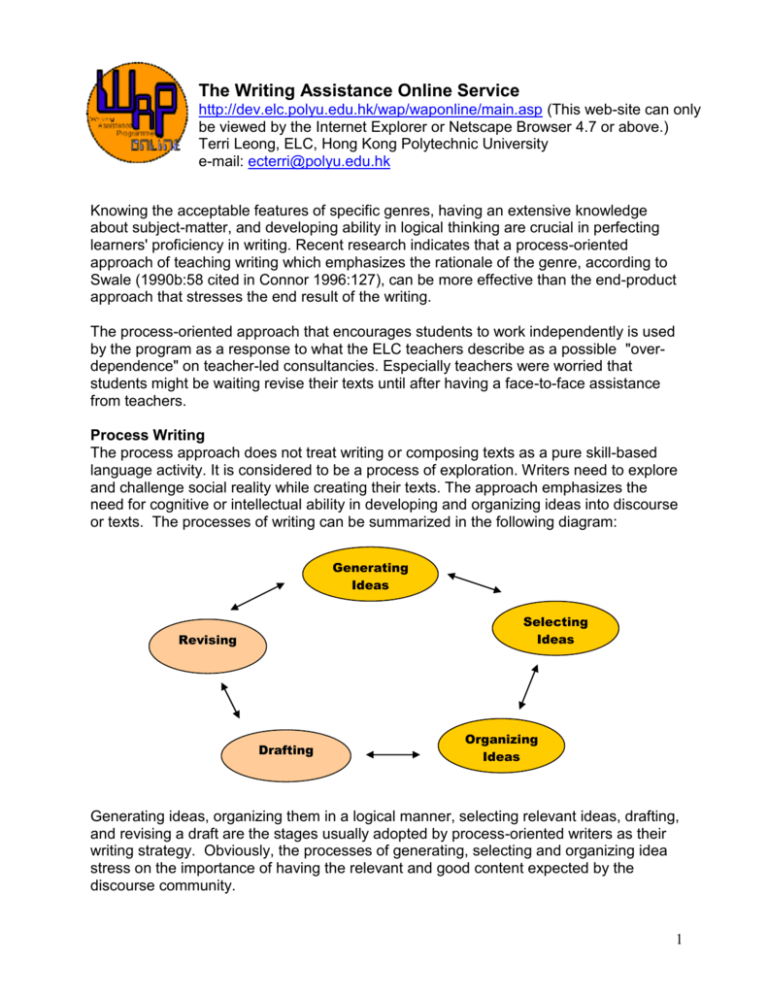
The Writing Assistance Online Service http://dev.elc.polyu.edu.hk/wap/waponline/main.asp (This web-site can only be viewed by the Internet Explorer or Netscape Browser 4.7 or above.) Terri Leong, ELC, Hong Kong Polytechnic University e-mail: ecterri@polyu.edu.hk Knowing the acceptable features of specific genres, having an extensive knowledge about subject-matter, and developing ability in logical thinking are crucial in perfecting learners' proficiency in writing. Recent research indicates that a process-oriented approach of teaching writing which emphasizes the rationale of the genre, according to Swale (1990b:58 cited in Connor 1996:127), can be more effective than the end-product approach that stresses the end result of the writing. The process-oriented approach that encourages students to work independently is used by the program as a response to what the ELC teachers describe as a possible "overdependence" on teacher-led consultancies. Especially teachers were worried that students might be waiting revise their texts until after having a face-to-face assistance from teachers. Process Writing The process approach does not treat writing or composing texts as a pure skill-based language activity. It is considered to be a process of exploration. Writers need to explore and challenge social reality while creating their texts. The approach emphasizes the need for cognitive or intellectual ability in developing and organizing ideas into discourse or texts. The processes of writing can be summarized in the following diagram: Generating Ideas Selecting Ideas Revising Drafting Organizing Ideas Generating ideas, organizing them in a logical manner, selecting relevant ideas, drafting, and revising a draft are the stages usually adopted by process-oriented writers as their writing strategy. Obviously, the processes of generating, selecting and organizing idea stress on the importance of having the relevant and good content expected by the discourse community. 1 WAP Online Program and Process Writing Setting and providing parameters of two specific genre: essays and job application Letters to help student writers to meet expectation of the reader or audience is what the WAP Online Program is attempting to achieve. The program provides users with two sets of questions and checklists to review their letters and essays, i.e. 11 revising questions and checklists for each genre. Each question focuses on an important aspect of the writing, e.g. style, punctuation, organization, content of different paragraphs, pitfalls, etc. Another important characteristic of the process approach is the attempt to play down the traditional role of grammar in writing. For process writers, having a thorough knowledge of English grammar is an advantage but should not be a prerequisite. The above diagram also shows that ideas and semantic contents are more important than the mechanical skills that can be dealt with if writers have a logical mind to associate meaning or ideas within the parameters of the specific genre. In fact, the genre exhibits distinctive discourse patterns in terms of sentence structure, style, tone, vocabulary, and cohesion. Writers can learn to master the structures by using or imitating the sentences illustrated in the model texts. In process writing, traditional grammar can be seen to be a set of systematic rules which arises naturally via logical associations. The issue of achieving accuracy or having correct grammar in writing is addressed by the revision of drafts in the process of writing. In other words, drafts can be polished or improved through the procedure of revising or reviewing. One of the techniques known as "conferencing" emerged from this (Nunan 1991:87). The aim of conferencing is for student writers to talk about their initial or final drafts with the teacher. Based on the rationale of the process approach to writing, the WAP Online service tries to address students' needs by creating an electronic learning facility to address the notion of writing improvement. The online-program can be an enhancement of a face-toface consultation/ conferencing session for individual help seekers of the Writing Assistance Programme of the English Language Centre in the Hong Kong Polytechnic 2 University. The one-to-one help provided by the WAP teachers helps students with various aspects of their writing. They try to help students to organize and find ways to develop their ideas understand what the expectations of their target reader might be learn the format that is expected for a particular writing task find appropriate ways to express their ideas use structure appropriately and accurately within their writing From a tutor's perspective, the constraining choice of content and style of specific genre makes the process of reviewing become manageable. For example, while revising, writers can focus on one paragraph at a time, check the topic sentence see if it is well elaborated with supporting statements. In the online-program, the series of systematically presented questions and checklists are used to raise student's awareness of discourse patterns in formal and informal situations. Three examples of a checklist found in the online-program are as follows: Do you have a topic sentence? Do you have a thesis? Make sure you also have the sentence that explicitly states the organisational structure of your essay (See the appendix) Each question in the checklist is also accompanied by explanation and examples i.e. model texts. Students can listen to and/or read guidelines and explanation, they can also view samples essays and application letters. One of the attractions of the program is its vivid image and sound presentation. In fact, the online-program can also be seen as a multi-media delivery of editing resources or materials for students' writers. The online-program also provides a data-driven learning environment on the Internet. It incorporates both dictionary and concordancing software developed by the Virtual Language Centre of Hong Kong Polytechnic University. With the help of a concordancer, students can 3 easily check and improve their writing in terms of vocabulary usage, sentence structures, idiomatic expressions, etc. Benefits of using WAP online Service This tutoring program aims to help student writers develop their ability to critically analyze their own texts. In other words, the facilities are presented in a virtual learning platform for writing improvement exercises via a PC or network-based computer. The actual benefit of the program has nothing to do with electronic intelligent checking or editing; it is mainly the provision of electronic resources to raise student's awareness about good writing. So, it is an alternative delivery mode for independent learning. From a user perspective, the program acts as a virtual learning platform for writing improvement. As a self-contained program, It can be easily navigated by users to allocate the resources they need for improving their writing. During the activity, students bring their working drafts on diskette and work in small groups on computer terminals for individual or peer reviewing by using the program. The rationale of the facility is the belief that it is the student not the computer who should be responsible for improvement in their writing. Students should take the initiative in the text-review process when using the program. As the process approach to writing is gaining more weight in the advanced level of education, it can be anticipated that the demand for seeking help through the face-to-face Writing Assistance Program will increase. It may become impossible for language teachers to preview and edit all student texts if the process approach is adopted in the classrooms. Thus, the online program may become a necessity in the near future. One of the advantages of the program is that digression cannot easily take place in the closed virtual learning platform as happens so frequently in face-to-face interaction. 4 The program can be used for either self-learning purposes or a lab teaching session where a teacher may take students into the computer lab to illustrate ways of reviewing their drafts. The process can be very effective if students are encouraged to discuss their writing with their peers while using the program and the teacher offers individual help or suggestions of their writing on the hard copy after using the program. Experience shows that students are more willing to take risks in writing if they have the opportunity to review the texts. One of the drawbacks about the online-program is that the issue of proofreading or error cleansing is not fully addressed. From the student's perspective, their primary concern is the need to edit and proofread their writing. Students seem to have the problem of not being able to proofread their own writing. To some Hong Kong students, it is a myth that they can be as proficient as native writer because it is not easy for them to recall the grammatical rules they have learned when they need them. The myth may even stop them from further exploring to develop their skill of writing. To ease their tension, the myth must be dispelled. The grammatical knowledge they gained in the past years needs to be applied and merge into their logical thinking while they are producing texts. The provision of sample texts in the program attempts to address the issue. Users can take a model sentence from the sample text and rewrite the sentence using their own vocabulary but imitating the sentence structure and parts of speech contained in the model. In this way, users can experiment and take more risk in using various sentence patterns in their writing. To conclude, the online-program employs a multi-media mode in delivering the writing materials and resources for revising purposes. The pedagogical design of the onlineprogram fully implements the belief that having a good knowledge of genre and being intellectual in the subject matter can not only help to enrich the content of students' writing but also give them urge to write and confidence to achieve their goal in writing. The successful adaptation of the rationale of genre approach to teach the process of revising job application letters and academic essays in Hong Kong context is the major achievement of the program. Students can access the facilities or service on the Internet in their own time so they are encouraged to work independently to revise their writing before they seek for any further face-to-face help from the teacher. The provision of the ideal virtual learning environment for users to review their writing with the webconcordancer and lexical dictionary is another contribution of the program. 5 References Connor, U. (1996). Contrastive Rhetoric, Cross-cultural aspects of second-language writing. USA: Cambridge University Press. Holland, V. M., Kaplan J. D. & Sams M. R. (1995). Intelligent Language Tutors. Lawrence Erlbaum Associates, Inc., Publishers. (pp 99-120). Nunan, D. (1991). Language Teaching Methodology. U.K.: Prentice Hall. (pp 83-99). Tomlinson, B. (1998). Materials Development in Language Teaching. UK: Cambridge University Press Warschauer, M., Kern R. (2000). Network-based Language Teaching. UK: Cambridge University Press. 6 Checklist for revising academic essays QUESTION 1: Introduction • Do you have a topic sentence? • Do you have a thesis? • Make sure you also have the sentence that explicitly states the organisational structure of your essay QUESTION 2: Narrow Your Topic • Be sure you have narrowed your topic in terms of where and when the topic refers to who is involved in the topic how and why the topic occurs what or which parts of the topic you are discussing. • Make sure you also have narrowed your topic efficiently and effectively to fit your purpose QUESTION 3: Capture Your Reader’s Interest • Have you included the information that will interest your reader? • Do you know why the reader is reading your essay? QUESTION 4: Thesis of Your Essay • Is it argumentative or expository? • Have you got a “for” or “against” dimension for your argumentative essay? • Have you revealed or exposed or explained the topic for your expository essay? QUESTION 5: Formulate a Thesis • Have you expressed your thesis in both your introduction and the conclusion? • Have you included any ideas that do not fit your thesis? • Do you have sufficient ideas to develop your thesis? QUESTION 6: One main Idea in one Paragraph • Do you have only one main idea in one paragraph? 7 QUESTION 7: Support your Thesis • Make sure that all of the paragraphs and their ideas support the thesis. • Be sure that the topic sentence and the ideas which support it are related to the thesis. • Have you brought in new ideas that are not relevant? • Have you discussed ideas that are not significant to the thesis? QUESTION 8: Order information • Have you developed the thesis very carefully, step-by-step? QUESTION 9: Main Body of the Essay • Make sure you have reviewed your topic, thesis, and structure sentences. • Have these three been all adequately covered by the main ideas in each paragraph? • Have some aspects of these three not been covered efficiently? • Has any aspect of these three been missing? QUESTION 10: Create Transitions • Have the paragraphs in the body of the text been well ordered? • Have you alerted your reader as to a change of main ideas? • Have you made your reader know exactly where s/he is in the structure of your essay? • Have you informed your reader about the ending? QUESTION 11: Write Conclusion • Have you restated the topic and thesis that you mentioned in the introduction? • Have you also summarised the structure / main points? 8
